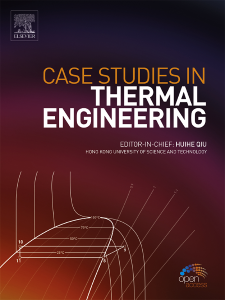Experimental study on thermal load characteristics of a U-bend pulse detonation combustor
IF 6.4
2区 工程技术
Q1 THERMODYNAMICS
引用次数: 0
Abstract
The performance of pulse detonation turbine engines (PDTE) surpasses that of conventional turbine engines, primarily due to the pressure gain combustion process inherent in PDTE. A U-bend pulse detonation combustor (PDC) with a compact axial length was designed to meet the requirements of PDTE. However, the PDC introduces complex thermal management challenges. In this study, the wall temperature along the U-bend PDC was experimentally measured under various operating conditions, the thermal load characteristics were investigated. The results indicate that the external wall temperature increases monotonically with prolonged operation, whereas the internal wall temperature exhibits periodic fluctuations corresponding to the periodic filling and combustion process in the PDC. The temperature difference between the internal and external walls increases, then decreases over time, eventually fluctuates within a narrow temperature range. The wall temperature was observed to increase along the flow direction, peaking at 811 °C at 30 Hz at the location where the detonation wave is generated. Similarly, the heat flux of the PDC first increases, then decreases, and eventually reaches a constant value, indicating thermal equilibrium. The heat flux represents a significant energy loss, with the detonation section being the area of highest heat loss, reaching approximately 90.5 kW/m2 at 30 Hz.
U 形弯曲脉冲爆燃燃烧器热负荷特性实验研究
脉冲爆燃涡轮发动机(PDTE)的性能超过了传统的涡轮发动机,这主要归功于脉冲爆燃涡轮发动机固有的增压燃烧过程。为满足 PDTE 的要求,设计了一种轴向长度紧凑的 U 形弯管脉冲爆燃燃烧器(PDC)。然而,PDC 带来了复杂的热管理挑战。本研究通过实验测量了 U 形弯曲 PDC 在各种工作条件下的壁温,并研究了热负荷特性。结果表明,外壁温度随着长时间运行而单调上升,而内壁温度则呈现周期性波动,这与 PDC 的周期性填充和燃烧过程相对应。内外壁之间的温差先是增大,然后随着时间的推移逐渐减小,最终在一个较窄的温度范围内波动。观察到内壁温度沿流动方向升高,在产生爆轰波的位置,30 Hz 时达到峰值 811 °C。同样,PDC 的热通量先上升后下降,最终达到恒定值,表明热平衡。热通量代表了大量的能量损失,起爆段是热损失最大的区域,在 30 Hz 时达到约 90.5 kW/m2。
本文章由计算机程序翻译,如有差异,请以英文原文为准。
求助全文
约1分钟内获得全文
求助全文
来源期刊

Case Studies in Thermal Engineering
Chemical Engineering-Fluid Flow and Transfer Processes
CiteScore
8.60
自引率
11.80%
发文量
812
审稿时长
76 days
期刊介绍:
Case Studies in Thermal Engineering provides a forum for the rapid publication of short, structured Case Studies in Thermal Engineering and related Short Communications. It provides an essential compendium of case studies for researchers and practitioners in the field of thermal engineering and others who are interested in aspects of thermal engineering cases that could affect other engineering processes. The journal not only publishes new and novel case studies, but also provides a forum for the publication of high quality descriptions of classic thermal engineering problems. The scope of the journal includes case studies of thermal engineering problems in components, devices and systems using existing experimental and numerical techniques in the areas of mechanical, aerospace, chemical, medical, thermal management for electronics, heat exchangers, regeneration, solar thermal energy, thermal storage, building energy conservation, and power generation. Case studies of thermal problems in other areas will also be considered.
 求助内容:
求助内容: 应助结果提醒方式:
应助结果提醒方式:


